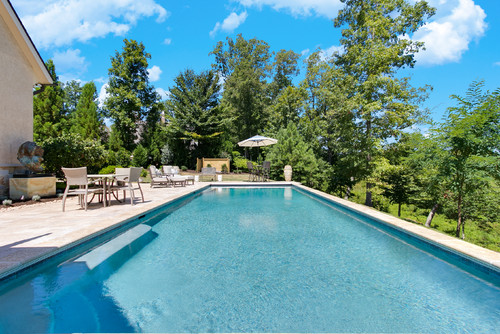By Larissa Runkle of Realtor.com
Longing for a trip to the ocean as the temperature rises? We are right there with you.
But what if we told you that you could have your very own private body of saltwater to cool off in this summer—no matter what landlocked corner you find yourself in?
Saltwater pools are the latest home and garden trend everyone is talking about—and with good reason.
Saltwater pools are gentler on the skin and more cost-effective than chlorinated pools, so it’s easy to see why pool owners across the country are considering making the switch. So what exactly is a saltwater pool, and how can you get one? Keep reading to find out.
What’s a saltwater pool?
Saltwater pools are pretty much what they sound like: pools that rely on salt (rather than chlorine) for maintaining ideal swimming conditions.
“The structure of the pool itself is the same; the only difference is in the pool chemistry and the equipment needed to maintain that chemistry,” says Joe Raboine, director of residential hardscapes at Belgard. “A homeowner can convert any type of pool to a saltwater pool, which converts salt to chlorine with a computerized salt generator that also monitors chlorine levels.”
Unlike regular pools that require you to add chlorine tablets every week, saltwater pools simply need their pH and salt levels monitored and salt replaced only when it gets low. As you can imagine, this means a lot less time and money needed for upkeep compared with a regular chlorinated pool.
“The annual maintenance costs for running a saltwater pool will be much less, about $100 per year versus $1,000 for chlorine and chemicals,” says Raboine.
What other pros and cons might you expect from a saltwater pool? We’ll dive into that below.
Cons of saltwater pools
The expense: While regular maintenance costs for saltwater pools are lower, you can expect to pay big bucks upfront to install your private salty pool.
A new saltwater pool will cost homeowners an average of $25,000, which is $10,000 less than the average cost of installing an in-ground chlorinated pool. Keep in mind that many homeowners convert existing chlorinated pools into saltwater pools, which requires a significant upfront expense.
“The cost of converting a chlorine pool to saltwater will range around $1,700 to $2,500 and will require a replacement every five to seven years,” says Stewart Vernon, founder of America’s Swimming Pool Co.
No DIY option:

How a salt chlorinator system works
(Graphic courtesy of leisurepoolsusa.com)
Before you start Googling “DIY chlorine pool,” hear this: You will want to make that investment for the professional pool installation. The reason? You’ll need to have something called a salt chlorinator system installed. And you likely also need some professional advice regarding the new liner and other external fixtures of your pool.
“If your pool’s finished with a plaster surface, the saltwater may corrode it faster and require you to refinish your pool more often,” says Vernon. “Saltwater may also corrode any metal pool components faster.”
Pros of saltwater pools
Less stink: Suppose you can get past the initial expense of installation. In that case, you’ll find yourself pleasantly surprised by several aspects of saltwater pool ownership—not the least of which is that saltwater pools are much less odiferous.
“There’s significantly less odor in a saltwater pool,” says Vernon. “A byproduct of chlorine called chloramines causes chlorinated pools to have that distinct chemical odor. And these chloramines are greatly reduced when converted to a saltwater pool.”

(Getty Images)
It’s better for your skin: Saltwater pools are gentler on your body.
“The main advantage of a saltwater pool is that it’s less harsh on your skin, eyes, and hair and requires less work to balance the chemistry in the water,” says Raboine. “You can even open your eyes underwater, and it doesn’t hurt because the salt levels are very close to the salinity of human tears.”




